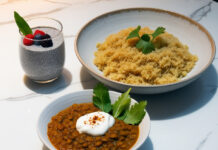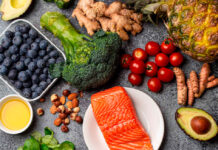
A growing number of families are interested in plant-based choices for themselves and their children. For parents, that means introducing foods thoughtfully to ensure kids are getting maximum nutrition, including plant-based protein.
Today’s plant-based eaters span a wide spectrum, from flexitarians, who only occasionally eat meat or fish, to vegans, who avoid consuming animal-based products at all. According to a Food Industry Association report, 81% of households with children include plant-based protein in meals and 40% of parents with children under 18 are incorporating more plant-based foods into their families’ diets.
“With a new generation of parents, we see changing food values and an increased interest to incorporate more plant-based meals into diets,” said Dr. Whitney Casares, Gerber’s pediatric medical consultant and a fellow of the American Academy of Pediatrics. “It can be challenging to find plant-based protein options that are appropriate for young eaters, and it can definitely be more work for families. Parents are becoming increasingly knowledgeable about how food choices influence overall health – not just for themselves, but their kids, too.”
If you’re looking for ideas to help you feed your child in line with your own plant-based food values, consider these tips from the experts at Gerber:
Incorporate plenty of colour. Be sure you’re feeding your little one a rainbow of colours representing a variety of foods, including whole grains, legumes, fruits, veggies, meats and fish. Offering your toddler lots of colourful foods makes it appealing to the eyes, but all those colours also represent diverse nutrients for healthy growth and development.
Layer legumes with other ingredients. Give meals an added protein punch by incorporating mild-flavoured beans with other, stronger flavours like berries. For example, Gerber Plant-tastic Organic Pouch Banana Berry & Veggie Smash with Oats is made with banana, berries, spinach, purple carrots, chickpeas and oats with 2 grams of plant protein and a full serving of fruits and vegetables.
Keep serving favourites. Offering new foods along with familiar favourites can help young children accept the new foods. It can take up to 10 times for a baby to accept new food, according to Casares, so don’t give up. Eating a variety of familiar foods and new additions throughout the week can also help little ones accept diverse options more readily.
Plan nutritious snacks. Meals aren’t the only time to focus on good nutrition. Smart snacks that are developmentally and nutritionally appropriate play an important role in your toddler’s overall diet. Options like Gerber Organic Plant-tastic Lil’ Crunchies White Bean Hummus Baked Snacks have a mild flavour that appeals to little taste buds while providing 2 grams of protein in each serving.
Remember dessert counts, too. You may not think desserts and nutrition fit together, but you can actually pour some good-for-you goodness into special occasions. Think berries, bananas and other naturally sweet ingredients for sorbets and smoothies, and keep in mind there are plenty of dessert-friendly ways to incorporate extra protein, such as nut butter or Greek yogurt.
Prep for easy access. Just like adults, kids are likely to nibble on what’s easy. Keep plant-based options readily available and prepared so they’re the first options little ones reach for when they’re hungry. Choosing healthy, plant-based options is easy if that’s what’s available.











